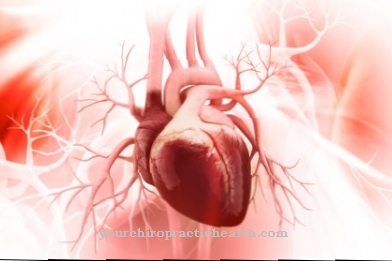Azathioprine belongs to the immunosuppressant group and is used in many ways in organ transplants, autoimmune diseases and certain chronic inflammations. The mode of action of the active ingredient is mediated via an inhibition of nucleic acid synthesis. Since the drug works with delays, it is always used in combination with other immunosuppressive drugs in organ transplants.
What is azathioprine?

Azathioprine is a drug used to suppress the immune system. It is used in the event of excessive, misdirected or undesirable immune reactions of the organism. This applies to rejection reactions in organ transplants, autoimmune reactions and other misdirected immune reactions of the organism.
The active ingredient consists of a purine ring that is connected to the heterocyclic imidazole ring via a sulfur bridge. In the metabolism, this compound is subject to several degradation reactions, in the course of which diverse intermediate compounds (metabolites) are formed. Important metabolites are 6-mercaptopurine and 1-methyl-4-nitro-5-thioimidazole. In the process, 6-mercaptopurine passes through the cell membrane, converting it into other active and inactive metabolites. 6-mercaptopurine is the actual metabolite that intervenes in the nucleic acid metabolism.
It is an analogous purine base that can be incorporated into DNA or RNA instead of the physiological purine base. In addition, the formation of new purine bases is inhibited as part of these metabolic processes. Overall, this leads to the inhibition of nucleic acid synthesis. The role of the other metabolite (1-methyl-4-nitro-5-thioimidazole) has not yet been clearly established.
Pharmacological effect
As already mentioned, the active ingredient uses its metabolites to inhibit nucleic acid synthesis. At the same time, this suppresses the formation of new cells, since the nucleic acids can no longer be provided in sufficient quantities. This particularly affects cells and organs that are dependent on a higher rate of cell division.
The immune system has to react quickly to foreign intruders and therefore quickly produce new immune cells, which are then subject to further differentiation. Azathioprine therefore has an antiproliferative effect, i.e. it inhibits cell division. The necessary T-lymphocytes, natural killer cells and B-lymphocytes cannot then be produced in sufficient quantities. The secretion of the tumor necrosis factor TNF-alpha is also reduced.
However, azathioprine only reaches its full effectiveness after two to five months. For this reason, therapy must be started with other faster-acting immunosuppressants, such as glucocorticoids or cyclosporine, in order to be effective from the start. The delayed effectiveness of azathioprine results from the slow decrease in nucleic acid concentration.
Medical application & use
Azathioprine has a wide range of uses. It is suitable for all areas of application that require suppression of the immune system. This applies to organ transplants, autoimmune reactions or allergic reactions. In almost all areas, this can improve and weaken inflammatory reactions.
A particularly important field of application is the use of the drug in organ transplants to weaken the rejection reactions. Autoimmune hepatitis or idiopathic interstitial pneumonia.
Azathioprine is also often used in severe atopic dermatitis. The same goes for such diseases as Crohn's disease or ulcerative colitis. All of these are diseases that are caused by the reaction of the immune system to the organs of the body.
You can find your medication here
➔ Medicines to strengthen the defense and immune systemRisks & side effects
In addition to the diverse areas of application, however, many contraindications, side effects, interactions and precautionary measures must also be observed. The enzyme thiopurine methyltransferase (TPMT) is only less effective in a relatively large proportion of the population (10 percent). Thiopurine methyl transferase (TPMT) is responsible for the metabolism of 6-mercaptopurine. As already mentioned, 6-mercaptopurine can be incorporated into DNA or RNA as an analogous purine base instead of the physiological purine base and thus hinder normal nucleic acid synthesis. Without the enzyme TPMT, this metabolite can no longer be effectively broken down and accumulates. This increases the toxicity of azathioprine.
The reduced nucleic acid synthesis also weakens the repair mechanism on the DNA in the event of mutations. Therefore, exposure to solar radiation should be as low as possible during treatment in order to reduce the risk of skin cancer.
Other contraindications for the use of azathioprine are liver and kidney dysfunction, severe infections or damage to the bone marrow. As azathioprine is embryotoxic, it must not be used during pregnancy.
Sometimes there are also unpleasant or even serious side effects. These include a general feeling of illness, nausea, vomiting, loss of appetite, changes in the blood count with the development of anemia, leukopenia or thrombocytopenia. In rare cases, megaloblastic anemia can also occur. Megaloblastic anemia is a form of anemia that results from impaired DNA synthesis. In men, a restriction in germ cell formation can sometimes be observed. However, this phenomenon is reversible and only occurs during treatment.



























